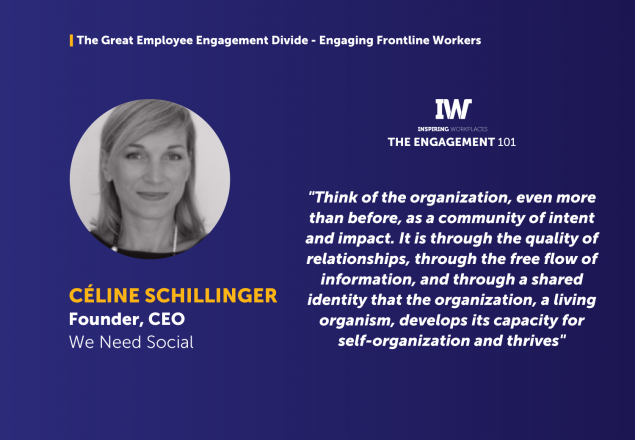
22nd May 2025
The Evolving Role of Middle Management in the Age of AI & Organisational Change

Despite predictions of their demise, middle managers remain crucial to organizational success in an AI-driven, fast-changing world. Rather than being eliminated, their roles are evolving—from supervisors to strategic change agents and digital stewards who bridge communication, guide employee development, and drive innovation through collaboration, empathy, and cross-functional influence.
This article was written by Gretchen Gavett and Vasundhara Sawhney, and published in HBR.
There has been no shortage of questions and predictions about the end of middle management—from the pages of HBR in 2011 to the BBC four years later. Despite this, the proportion of middle managers has actually grown, making up 13% of the U.S. labor force in 2022, up from 9.2% in 1983.
More recently, however, there have been new warnings about the demise of this role. Gartner predicts that through 2026, “20% of organizations will use AI to flatten their organizational structure, eliminating more than half of current middle management positions.” Forty-four percent of U.S. professionals say that their company has cut back on manager-level roles, according to a new Korn Ferry report. And with comparatively high rates of burnout and unhappiness among middle managers—a new Gallup survey finds that managers are experiencing the sharpest decline in engagement—you have to wonder whether something is amiss with what companies are tasking these employees to do.
To help unpack these trends, we reached out to three groups of experts and asked: What’s the future of middle management, really? Here are their answers, edited for clarity.
From Line Managers to Agents of Change
Raffaella Sadun is the Charles Edward Wilson Professor of Business Administration at HBS and Jorge Tamayo is an assistant professor at HBS. Their current research examines the pivotal role of middle managers in driving performance disparities within firms.
Organizations today face significant technological and competitive shifts that are reshaping how they operate. Advances in generative AI are no longer confined to routine tasks; they now encroach on white-collar, managerial functions, challenging the assumption that these roles are insulated from automation. At the same time, the need for customer-centricity has never been more pressing. To remain competitive, organizations must reduce the bureaucratic distance between senior leadership and end customers, enabling greater agility and responsiveness.
One response to these shifts has been the call for delayering—the removal of middle management to improve productivity, agility, and employee motivation. But this overlooks a crucial reality: middle managers have never been more important. In times of transformation, they play a vital role in shaping an organization’s ability to adapt.
Their significance rests on two key functions.
First, as the link between frontline employees and senior leadership, middle managers have direct access to customer insights. They are uniquely positioned to detect shifts in customer needs and relay this critical information to decision-makers. In times of heightened uncertainty, when organizations must rapidly refine their value propositions, this feedback loop becomes indispensable.
Second, middle managers serve as coaches and mentors, translating strategic shifts into action at the ground level. As technological change reshapes job roles, they guide employees through transitions, helping them acquire new skills and adapt to evolving responsibilities. Recent research underscores this point: middle managers play an essential role in motivating employees to pursue training, facilitating the development of human capital, and supporting workers as they navigate career paths within organizations. They also act as key intermediaries in supervising and interpreting AI-driven tasks, ensuring that automation enhances—rather than replaces—human expertise.
While eliminating middle management would be counterproductive, this does not mean that organizations can afford to maintain the status quo. As firms rethink their decision-making processes and organizational structures, our ongoing research finds that middle managers must develop new skills and embrace new responsibilities. Their role is shifting from oversight to facilitation, from monitoring to capability-building.
In essence, middle managers must become change agents.
The problem is, in many organizations, middle managers are not empowered to perform this role. For example, instead of leveraging them to understand customer needs or to coach and motivate employees, companies often assign middle managers to routine administrative tasks that could easily be automated. This misallocation of responsibilities dramatically reduces their potential impact. Rather than supervising day-to-day processes, middle managers should be guiding employees through skill transitions, facilitating collaboration across teams, and helping integrate new technologies into operations.
Even when organizations recognize the need for middle managers to take on these expanded roles, they often fail to provide the necessary training to make these shifts. The increasing emphasis on “soft skills” training—so essential for coaching and motivation—has not been matched by consistent quality in content and delivery. Furthermore, middle managers will also require technical upskilling to stay ahead of automation. As AI assumes responsibility for lower-level problem-solving, managers must shift their focus to higher-order challenges, developing analytical and strategic skills that make them complementary to, rather than substitutable by, technology.
Beyond training, another barrier to effective middle management lies in how organizations select and evaluate their managers. Many firms continue to promote individuals based on performance in unrelated tasks—such as rewarding top salespeople with managerial roles—without considering whether they have the ability to mentor, coordinate, or drive change. Worse, managerial success is often measured in ways that fail to capture their most critical contributions. If organizations do not assess and incentivize mentoring, coaching, and cross-functional collaboration, they will struggle to unlock the full potential of their middle managers.
Middle management is not an obstacle to agility—it is a cornerstone of it. Organizations that recognize this will be best positioned to thrive in an era of rapid change. Firms that fail to rethink and reskill their middle managers risk losing a critical layer of leadership precisely when they need it most.
From Supervisors to Stewards of Digital Transformation
Zahira Jaser is an associate professor at the University of Sussex Business School and the author of the HBR article, “The Real Value of Middle Managers.”
In the era of digitization and algorithmic management, technology is increasingly designed to make decisions that were once the responsibility of managers (e.g., organizing shifts, controlling quality, and performance management). Consequently, there may be an expectation that fewer middle managers are needed, particularly those in supervisory roles.
However, an analysis of 34 million job postings over 14 years reveals not only a marked increase in the number of managers, but also that the role of middle managers has already begun to evolve, necessitating more collaborative skills than supervisory ones due to constant change and innovation. As a qualitative researcher who has interviewed hundreds of middle managers, this resonates with my findings, particularly in the vital role middle managers play in successful digital transformations.
Read this article in full here: What’s the Future of Middle Management?







